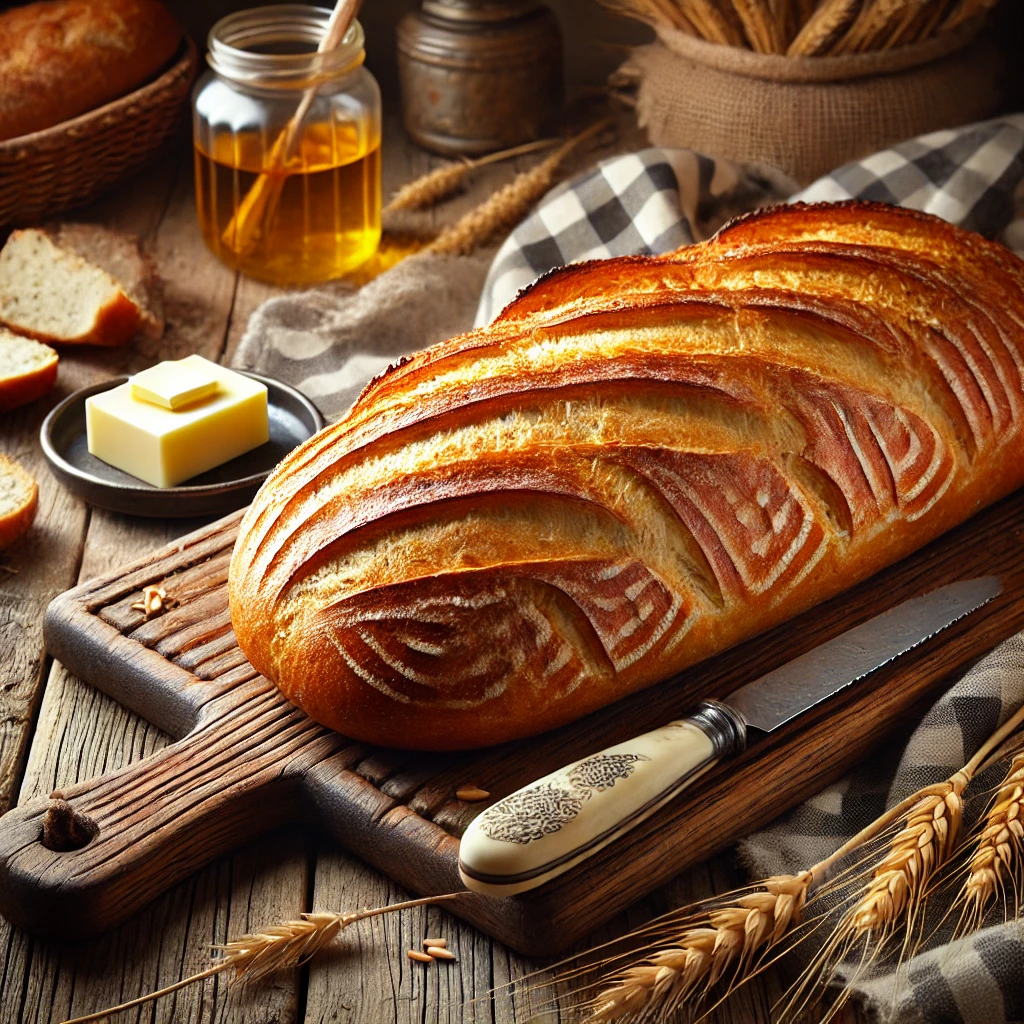Baguette: The Classic French Bread with a Crispy Crust That Captures the Essence of France
There’s a certain charm in biting into a freshly baked baguette . That crunch as you break through the golden crust, the soft and airy interior, and the unmistakable aroma—it’s no wonder the baguette is a symbol of French culinary tradition. Whether you’re enjoying it with a smear of butter at breakfast or dipping it into a hearty soup at dinner, this holds a special place in the hearts of bread lovers around the world. Let’s explore everything that makes this iconic bread so beloved.
What Is a Baguette?
Defining Characteristics of a Classic Dough
This is not just any loaf of bread. Its defining features include its long, thin shape, crispy golden crust, and tender, airy interior. By French standards, a traditional Dough measures about 26 inches (65 cm) in length, making it as visually impressive as it is delicious. The dough is simple but precise, with a high hydration level that contributes to its unique texture.
A Brief History of the Dough
The history of the Dough is as fascinating as its flavor. While its exact origins are debated, one popular theory traces it back to Austria in the 19th century, where Viennese bakers introduced new techniques and steam ovens. Napoleon Bonaparte is also said to have influenced its design, as the elongated shape made it easy for soldiers to carry. By the 20th century, the Dough had become a staple of French daily life, even earning a legal definition in 1993 with France’s “bread decree.”
Fun Fact: The word “baguette” means “wand” or “stick” in French, perfectly describing its shape.
How Are Baguettes Made?
Key Ingredients for a Traditional Dough
Creating the perfect Dough starts with the right ingredients. Here’s what you’ll need:
| Ingredient | Quantity | Notes |
|---|---|---|
| Bread flour | 500g | High-protein flour |
| Water | 350ml | Lukewarm |
| Salt | 10g | Enhances flavor |
| Yeast | 7g | Active dry or fresh yeast |
These simple ingredients, when combined with skill and care, produce a bread that’s nothing short of extraordinary.
Step-by-Step Process
-
Mix the Dough: Combine the flour, water, yeast, and salt, kneading until smooth and elastic.
-
First Proofing: Allow the dough to rest until it doubles in size.
-
Shape the Loaves: Divide the dough and form it into the classic elongated shape.
-
Final Proofing: Let the loaves rest again to achieve the perfect texture.
-
Scoring: Use a sharp blade to make diagonal slashes on the surface.
-
Bake with Steam: Bake at a high temperature, adding steam to create the signature crispy crust.
Pro Tip: A baking stone or steel can mimic the high heat of traditional French ovens, ensuring an authentic crust.
The Cultural Significance of Baguettes
The Baguette as a French Icon
In France, the baguette is more than just bread; it’s a cultural symbol. It represents simplicity, craftsmanship, and the daily rhythm of life. Morning trips to the boulangerie (bakery) for a fresh baguette are a cherished ritual for many French families.
Everyday Life in France
Baguettes are a staple in French meals, from breakfast with butter and jam to accompanying cheese and wine at dinner. French law even ensures that baguettes are affordable for everyone, cementing their role as an essential part of daily life.
Global Appeal
The baguette’s reputation has spread far beyond France . Bakers worldwide have embraced its techniques, adding their own regional twists. From herb-infused loaves in Italy to stuffed variations in the United States, the baguette’s influence is undeniable.
Tips for Enjoying and Serving Baguettes
Pairing Suggestions
-
For Breakfast: Spread with butter and your favorite jam.
-
For Lunch: Use as the base for a classic jambon-beurre sandwich.
-
For Dinner: Serve alongside soups, stews, or a curated cheese board.
Storing and Reheating Tips
-
Short-Term Storage: Wrap your baguette in a paper bag to maintain its crispness.
-
Freezing: Wrap tightly in plastic wrap and store in the freezer for up to three months.
-
Reheating: Lightly mist with water and bake at 350°F (175°C) for a few minutes to restore its texture.
Creative Uses for Stale Doughs
Don’t let stale bread go to waste! Transform it into:
-
Crunchy croutons for salads.
-
A flavorful addition to French onion soup.
-
Sweet bread pudding for dessert.
Baguette Recipe Variations
Classic Variations
-
Pain de Campagne: A rustic version made with whole wheat flour.
-
Baguette À L’Ancienne: A longer fermentation process for enhanced flavor.
Modern Twists
-
Herb-infused baguettes with rosemary, thyme, or garlic.
-
Stuffed baguettes filled with cheese, olives, or sun-dried tomatoes.
-
Sweet variations, like chocolate chip baguettes.
Conclusion: The Timeless Charm of the Dough
The Dough isn’t just bread; it’s a piece of history, a culinary art form, and a source of daily joy. Whether you’re savoring it fresh from the oven or using it as a canvas for creative recipes, the baguette invites you to appreciate the beauty in simplicity. So why not bring a taste of France to your table? Pick up a fresh baguette today, or better yet, try baking your own!
FAQ Section
What makes a Dough crispy?
The high hydration dough and the use of steam during baking create the baguette’s iconic crispy crust.
How long does it take to bake a Dough?
From start to finish, including proofing time, the process takes around 6 hours.
Can I make a this without a baking stone?
Yes, but using a baking stone or steel enhances heat distribution for a better crust.
How do you keep a Dough fresh overnight?
Wrap it in a paper bag or kitchen towel to preserve its texture.
Are are vegan?
Traditional contain no animal products, making them naturally vegan.
Embrace the joy of baking or simply savoring this classic French bread. The is more than a meal—it’s an experience.





